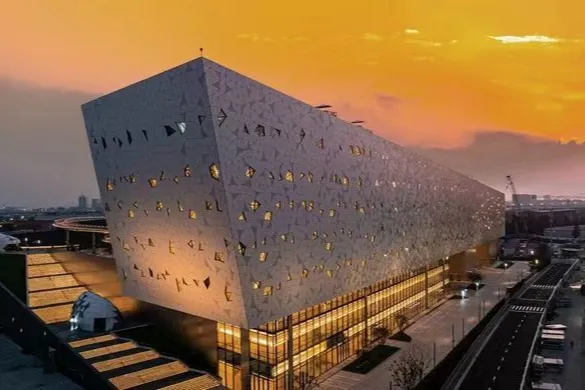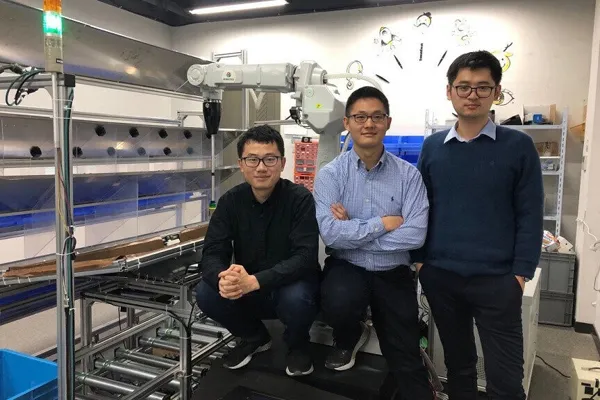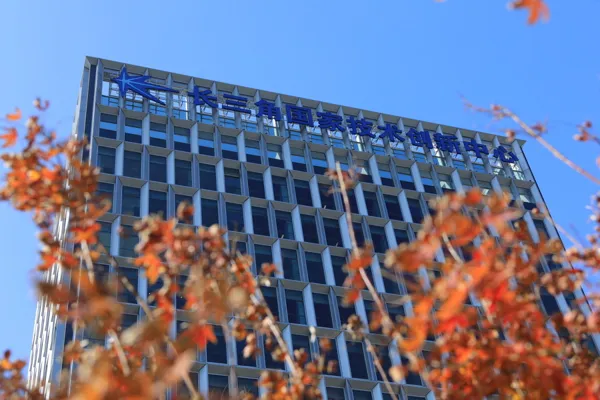In order to stimulate the "nuclear explosion point" of the industry, how to kick off the "final kick" of scientific and technological innovation? Zhangjiang "accelerates" with innovation
Shi Zhiru, general manager of the Digital Twins Division of Dijing Digital Technology Co., Ltd., has never forgotten that five years ago, he listened to General Secretary Xi Jinping’s sincere instructions to scientific and technological workers in the exhibition hall of Zhangjiang Science City - to enhance the sense of urgency and mission in scientific and technological innovation. Put technological innovation in a more important position, kick it off well, and let technological innovation play a major role in implementing the innovation-driven development strategy and accelerating the conversion of old and new driving forces.
At that time, he was an assistant research professor at ShanghaiTech University and was on hand to assist in demonstrating the school’s multiple artificial intelligence research results. Now, he has "transferred" to a technology start-up company incubated by ShanghaiTech University, and is committed to industrializing the "3D video fusion technology" demonstrated previously.
From cutting-edge innovation to joining the industry, it is not just Shi Zhiru’s personal struggle. The current Zhangjiang Science City, keeping in mind the General Secretary’s instructions, is taking innovation as the guide to instigate the “nuclear explosion point” of future industrial development.
Just like the engine of a sports car, as the core carrying area for the construction of Shanghai Science and Technology Innovation Center, Zhangjiang Science City continues to improve its original innovation capabilities, has strong source functions, and has achieved a number of landmark results in the field of basic research and key core technologies.
Shanghai has made important contributions to the well-known major scientific and technological achievements such as Jiaolong, Tiangong, Beidou, Tianyan, and Mozi. It has made important contributions to the "Tianwen-1" Mars exploration, the "Chang'e 5" moon landing, and the "Struggler" 10,000-meter It has continued to contribute "Shanghai wisdom" in major tasks such as sea trials, "Xuelong 2"'s maiden voyage to Antarctica, and the "Tianhe core module" being launched into orbit. my country's first independently developed large aircraft, the C919, took to the skies, a kilometer-level high-temperature superconducting cable was launched for demonstration, and a 100-kilowatt micro gas turbine filled the domestic gap.
Shanghai results are selected into the top ten scientific advances in China every year, and a total of 3 results were selected in 2022. In recent years, Shanghai scientists have created the world's first somatic cell cloned monkey model with biological rhythm disorder, led domestic scholars to contribute to the world's first "black hole" photo, and relied on the Shanghai Light Source to take the lead in analyzing the three-dimensional spatial structure of the new coronavirus in the world. In 2022, there will be 185 high-value invention patents per 10,000 people, much higher than the city's 41 patents.
According to the "2022 World-renowned Comprehensive Science Center Competitiveness Index" released by the Shanghai Institute of Science, Technology, Innovation and Open Economic Strategy, the Zhangjiang Comprehensive National Science Center is on the same level as comprehensive science centers such as Cambridgeshire in the UK and Hamburg in Germany.
In the first half of this year, Zhangjiang Science City achieved a regional GDP of 151.2 billion yuan, a year-on-year increase of 10%. From January to August, tax revenue was 32.013 billion yuan, a year-on-year increase of 19.2%, and the full year is expected to exceed 40 billion yuan for the first time. Realized fixed asset investment of 29.020 billion yuan, a year-on-year increase of 24.2%. The industrial output value of enterprises above designated size reached 238.039 billion yuan, accounting for nearly 1/3 of Pudong New Area.
Despite external shocks and the impact of the three-year epidemic, Zhangjiang's innovation resilience is increasing. From 2018 to 2022, the total operating income of Zhangjiang Science City will grow at a compound rate of 12.9%, the total tax revenue will be the total of the previous 10 years, and the total fixed asset investment of the whole society will exceed the total of the previous 10 years. "The inherent innovation capabilities of Zhangjiang Science City have been significantly improved, allowing people to see greater room for growth in the future, and it is ready for development." said Zhou Wen, distinguished professor at Fudan University and vice president of the Chinese Society of Political Economics.
Shanghai's three leading industries are showing high growth in Zhangjiang. The international academic journal "Nature" recently announced the most noteworthy new technologies in 2023, such as gene editing, cell therapy, AI pharmaceuticals, etc. "Zhangjiang has taken the lead in many fields in recent years, and many innovations are at the forefront of the world. Nearly half of the country's AI pharmaceutical research and development projects and 70% of Shanghai's immune cell therapy projects are in Zhangjiang." Academician of the Chinese Academy of Sciences, Pudong New Area Biomedical Industry Chen Kaixian, chairman of the Development Expert Committee, said at the Zhangjiang Life Sciences International Innovation Summit in September this year. In the first three quarters of this year, a total of 4 Class 1 new drugs were launched in Zhangjiang, and 2 Class 3 innovative medical devices were approved for marketing. Zhangjiang currently has more than 1,300 drug pipelines under development, of which original new drugs account for more than half.
Zhangjiang is home to nearly 500 integrated circuit companies, with annual sales accounting for about two-thirds of the city. It is the integrated circuit industry base with the most complete industrial chain, the most advanced comprehensive technology, and the strongest independent innovation capabilities in China. It has attracted 7 global integrated circuit companies. The top ten circuit design companies have set up regional headquarters and R&D centers here.
Recently, the Zhangjiang Future City project was launched, which will create a new paradigm of digital twin AI city 2.0. Zhangjiang has gathered more than 600 artificial intelligence companies and has become a gathering place for top AI giants. Zhangjiang Artificial Intelligence Island has been built as the country's first demonstration area for artificial intelligence innovation and application. The "Zhangjiang Digital Chain" characteristic industrial park focuses on the layout of next-generation computing power platforms and future intelligent interactive terminals.
Zhangjiang has a "tropical rainforest-style" innovative ecology, where towering trees and shrubbery coexist and prosper. More than 20,000 companies have gathered here, including more than 1,900 high-tech companies, 69 regional headquarters of multinational companies, 181 foreign-funded R&D centers, and 102 listed companies.
The originally "long and narrow" Zhangjiang Science City has now "grew in weight", expanding from 95 square kilometers to about 220 square kilometers. One year ago, the "Three-Year Action Plan for Zhangjiang Science City Expansion and Quality Improvement" was officially issued.
In order to compete for a "place" in the world's high-tech field, Zhangjiang High-tech Park was launched in 1992, two years earlier than the scheduled schedule. It was the only development zone named "High-tech Park" in my country at that time. Today, such pioneering trials are still happening in Zhangjiang. In September this year, Zhangjiang took the lead in piloting industrial land flexible planning and functional composite policies, innovating new paths for conversion of existing industrial land use; expanding the "white list enterprises" for the entry of biomedical special items to 11. These enterprises have imported multiple times within a year and do not need to repeat them. Assessment; taking the lead in launching a Shanghai biomedical real-world data research pilot...
In addition to science, this place is also a "city".
The curtain wall of the future landmark building "Science Gate" has recently been capped and is expected to be completed and delivered in 2025. In September last year, Shanghai's scientific and technological innovation landmark "Zhangjiang Science Hall" made its debut as the Pudong Branch Venue of the World Artificial Intelligence Conference, opening the "Home Page of Scientific and Technological Innovation". In September this year, the Zhangjiang cement plant renewal project designed by Pritzker Prize winner Tadao Ando was released. In the future, it will create an ideal scientific and technological innovation space in the minds of scientists.
Zhangjiang Cement Plant Renovation Project led by Tadao Ando.
The vitality of "city" comes from people. Zhangjiang Science City currently employs about 500,000 people, of which more than 16% are talents with a master's degree or above. Overseas high-level entrepreneurial talents account for about 50% of Shanghai's population. In order to allow more talents to come from near and far away, the "residence transfer" can be settled in as soon as 3 years...
"I was inspired when I listened to the general secretary's words live five years ago. We are building a digital twin city in Shanghai to serve the digitalization of urban governance. Through the flow of data, we will make Shanghai safer, more efficient, and warmer." Shi Zhiru lunch After being interviewed by a reporter from Jiefang Daily and Shangguan News, he rushed to see clients without taking time to eat. From innovation to entrepreneurship, he feels that such busyness is very fulfilling.




